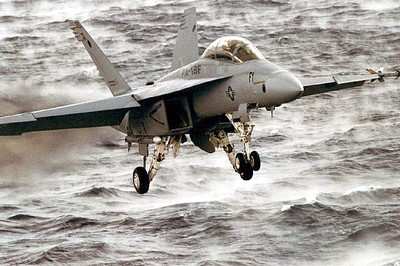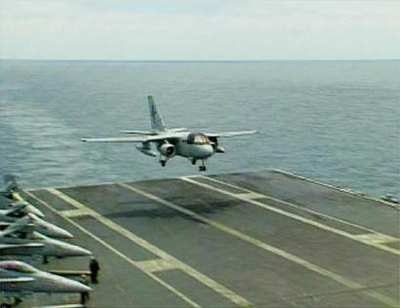Mon, Oct 24, 2011
Office Of Naval Research To Start Testing Next Year
Select pilots in early 2012 will commence testing new flight
control software, funded in part by the Office of Naval Research
(ONR), intended to facilitate aircraft landings on Navy carrier
decks with unprecedented accuracy. "The precision that we can bring
to carrier landings in the future will be substantial," said
Michael Deitchman, deputy chief of naval research for naval air
warfare and weapons. "The flight control algorithm has the
potential to alter the next 50 years of how pilots land on carrier
decks."

Navy and Marine Corps aviators conducting carrier landings today
line up with a moving flight deck in a complicated process. They
must constantly adjust their speed and manipulate the aircraft's
flight control surfaces-ailerons, rudders and elevators-to maintain
the proper glide path and alignment to the flight deck for an
arrested landing. Throughout their approach, pilots eye a set of
lights-known as the Fresnel lens-located on the left side of the
ship. It signals whether they are coming in too high or too
low.
The new algorithm embedded in the flight control software
augments the landing approach. Coupled with an experimental
shipboard light system called a Bedford Array and accompanying
cockpit heads-up display symbols, the software ties the movement of
the pilot's control stick directly to the aircraft's flight path.
Instead of constantly adjusting the plane's trajectory indirectly
through attitude changes, the pilot maneuvers the aircraft to
project a dotted green line in the heads-up display over a target
light shining in the landing area.
"It is almost like a video game," said James "Buddy" Denham, the
senior engineer who has been leading the research and development
efforts at Naval Air Systems Command. "You're tracking a shipboard
stabilized visual target with a flight path reference, and the
airplane knows what it needs to do to stay there."

ONR funded the project as part of its focus on sea-based
aviation, one of five Navy and Marine Corps research areas
designated as a national naval responsibility. The software has
been incorporated into an F/A-18 E/F Super Hornet flight simulator.
Researchers plan to conduct a study with U.S. Navy pilots and
British Royal Navy pilots who will fly the simulator to obtain data
on workload reduction and touchdown performance. Once the results
are tabulated, the engineers plan to integrate the refined
algorithm onto an actual aircraft for flight tests and
demonstrations.
If the tests are successful, the software could be integrated
aboard current and future aircraft to change the way carrier-based
aviators have landed aboard ships for more than half a
century-controlled crash landings. Increasing the precision of
landings will boost pilot safety and reduce training requirements
necessary to perfect carrier-landing skills. It could lower
aircraft life cycle costs by reducing maintenance and avoiding
repairs caused by hard landings.
More News
Maximum Authorized Altitude A published altitude representing the maximum usable altitude or flight level for an airspace structure or route segment. It is the highest altitude on >[...]
Aero Linx: Soaring Safety Foundation (SSF) The Soaring Safety Foundation (SSF) is the Training and Safety arm of the Soaring Society of America (SSA). Our mission is to provide ins>[...]
From 2013 (YouTube Version): Dracula Lives On Through Kyle Franklin... and We're NOT Scared! ANN CEO and Editor-in-Chief, Jim Campbell speaks with Aerobatic and airshow master, Kyl>[...]
“For Montaer Aircraft it is a very prudent move to incorporate such reliable institution as Ocala Aviation, with the background of decades in training experience and aviation>[...]
Also: ForeFlight Upgrades, Cicare USA, Vittorazi Engines, EarthX We have a number of late-breaking news highlights from the 2024 Innovation Preview... which was PACKED with real ne>[...]
 ANN's Daily Aero-Term (04.14.24): Maximum Authorized Altitude
ANN's Daily Aero-Term (04.14.24): Maximum Authorized Altitude ANN's Daily Aero-Linx (04.14.24)
ANN's Daily Aero-Linx (04.14.24) Classic Aero-TV: 'We're Surviving'-- Kyle Franklin Describes Airshow Life 2013
Classic Aero-TV: 'We're Surviving'-- Kyle Franklin Describes Airshow Life 2013 Aero-News: Quote of the Day (04.14.24)
Aero-News: Quote of the Day (04.14.24) Airborne 04.09.24: SnF24!, Piper-DeltaHawk!, Fisher Update, Junkers
Airborne 04.09.24: SnF24!, Piper-DeltaHawk!, Fisher Update, Junkers




